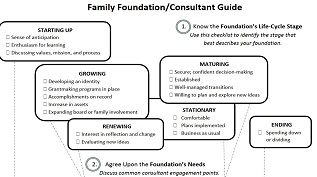Family Foundations Consultants Guide

Adapting existing research on the organizational life-cycle framework and working from a sample of foundations provided by the National Center for Family Philanthropy, GMA Foundations teamed with Brandeis University’s Sillerman Center for the Advancement of Philanthropy to conduct a pilot study to understand how planning ahead at each stage could help the foundations anticipate and prepare for likely milestones. The authors surveyed 40 family foundations of varying size and age about their experiences engaging outside experts.
The study findings, published in The Foundation Review, introduces the Family Foundation Life Cycle as a lens for understanding a foundation’s operations and makes recommendations to guide a board’s process for identifying the need for help and selecting consultants. Read the full article here.
The Life Cycle Stages
While the impetus for establishing a family foundation may differ for many, most hold on to the core values that represent the families’ philanthropic legacy. This continued dedication to preserving a legacy and to sharing decision making among members of a family is often a significant influence on a foundation’s governance and operations. This was evident in the range of governance and grantmaking practices reported in the survey.
At conferences or gatherings, family foundation leaders may describe their organizations using indicators such as asset size, grantmaking interests, and years of existence; however, foundations with similar asset sizes or inception dates are often at very different stages of development. A description of that stage is a more useful way of thinking about the foundations’ needs, challenges and progress towards its governance and operations goals. This life cycle offers a means of developing a common language around foundation needs and goals:
The Family Foundation Consultant Guide
The life cycle creates a useful lens for anticipating when external help from a consultant may be beneficial, and a language for sharing common experiences that is particularly useful for foundations as they look to engage consultants. With the life cycle as framework, we developed a practical Guide for trustees and staff to use when considering the integration of external resources in their work.
The Guide is a handy document to refer to in planning discussions, but it would not be complete without the Recommendations found on pages 24-27 in The Foundation Review, vol.7 iss.1. Gathered from our survey participants and from GMA’s 30 years of experience in this field, the recommendations are key elements of a board’s process for agreeing on clear goals and, when adopted, will increase the likelihood of successful consultant engagements.

